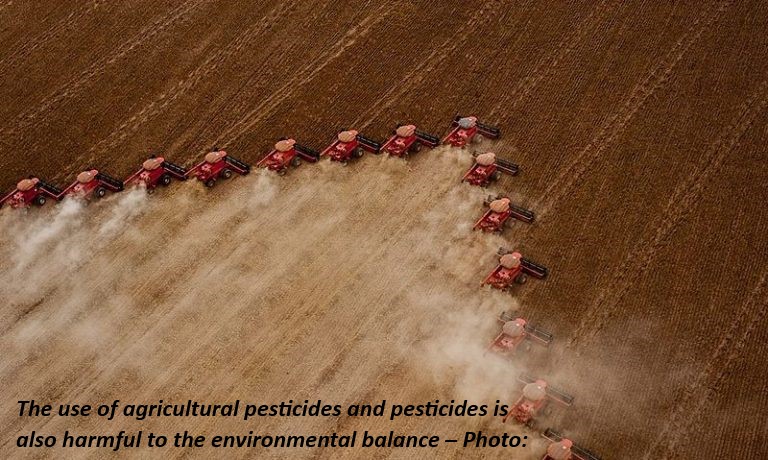Agri-business favors environmental and climate imbalance, says researcher
Model based on monoculture and use of pesticides still harms food production and increases costs

Above-average rainfall in southern Brazil, damaging food production and increasing prices; historic drought in the Amazon, impacting fishing activities, especially riverside communities. These are some examples of how the climate crisis hit Brazil hard.
For Luiz Marques, professor in the History department at the State University of Campinas (Unicamp) and author of the book “Capitalism and Environmental Collapse,” the agribusiness model contributes to the emission of greenhouse gases, which has changed in an increasingly the climate is more severe. The use of agricultural pesticides and pesticides is also harmful to the environmental balance.
“This agricultural model based on monoculture and cattle farming aimed at export has an impact on the destruction of the Brazilian vegetation cover, not only the Amazon but in other biomes. It is simply suicidal for the agribusiness culture itself, for Brazilian society and for our biodiversity,” he analyzes.
The professor also denounces the “destructive” role of cattle farming, one of the main causes of deforestation in the Amazon and the production of methane. “These cattle produce a brutal amount of methane, one of the main gases that contribute to the greenhouse effect, having an impact of 86 times greater CO2 in a period of 20 years. (…) If you take the inventory of greenhouse gas emissions in Brazil, around 75% result from agribusiness activities, with a large preponderance in cattle farming”, he analyzes.
Connected impacts
With the advance in deforestation, mainly in the Amazon region, there is a loss in the production of humidity, important for the formation of the so-called “flying rivers”, which causes the balance of rainfall in the central-southern region of the country.
Flying rivers are atmospheric watercourses, formed by air masses loaded with water vapor, often accompanied by clouds and propagated by winds.
With the lack of rain in the north, which is facing a historic drought, weather events have become increasingly extreme, alternating between droughts with high temperatures and floods.
Professor Eloy Casagrande, PhD in mineral resources and environmental engineering from the University of Nottingham (England) and environmental auditor at EARA, explains that the amount of moisture released in the Amazon irrigates rain in the south and southeast.
“The amount of water that moves from the Amazon region to the south, southeast and central west — and which can sometimes be greater with the water often evaporated by the tree canopy — can be greater than the flow of the River Amazonas, around 200,000m³ per second,” he says.
An article published in 2019 by researcher Marcos Heil Costa, an engineer with extensive experience in climate, land use, carbon cycle, water and agriculture in Central Brazil and the Amazon, mentions that the increase in the dry season in the Amazon states is already threatening harvests of soybeans and corn.
“The lack of rain in the 2020-2022 period has caused crop failures in important food-producing regions in Brazil, with famine and colossal losses for corn, sugar, coffee, wheat and orange farmers. Because of this, the 2020/2021 corn harvest was 15% lower than the 2019/2020 harvest,” reports professor Luiz Marques to Jornal da Unicamp, citing the article by Marcos Heil.
Production losses and price increases
For family farming, which has fewer resources to deal with problems related to droughts or excessive rainfall, climate impacts have harmed production.
According to data from the yearbook of the National Confederation of Agricultural Workers, there are almost 3.9 million family farming properties in the country, representing 77% of all agricultural establishments, with food production reaching the eighth largest on the planet.
For family farmer Elizete Pereira, from the 8 de Abril settlement, in Paraná, with climate change it has been difficult to plan production. “When it's very dry, you lose out due to the lack of [food] growth and not raining at the right time, and not having the possibility of irrigation. When it rains too much, you lose beans, you lose rice,” she says.
In Paraná, for example, above-average rainfall for spring has caused an increase in vegetable prices. According to the Agricultural Conjuncture Bulletin for the week of October 12th to 19th, Curitiba, which is responsible for 40.9% of vegetable farming activities, had an accumulation of 394 millimeters of rain until the 17th. historical average of 100 to 190 millimeters for the month of October around the capital.
A survey that analyzes the price variation of the 30 main products sold at the Paraná Supply Centers (Ceasa), especially in Curitiba, shows that 11 of these products have seen an increase in value since the beginning of the month, influenced by bad weather.
Lettuce went from an average price of R$ 15.00 per 7 kilo box (value recorded on October 2nd), to R$ 30.00 on the 18th. Strawberries showed an increase of 94.4%. At the beginning of the month, four trays (1.5 kilos) cost an average of R$18.00, and now they are purchased for R$35.00.
*This article is part of the Brazil edition of Fato Paraná – Special 20th Journey of Agroecology.
